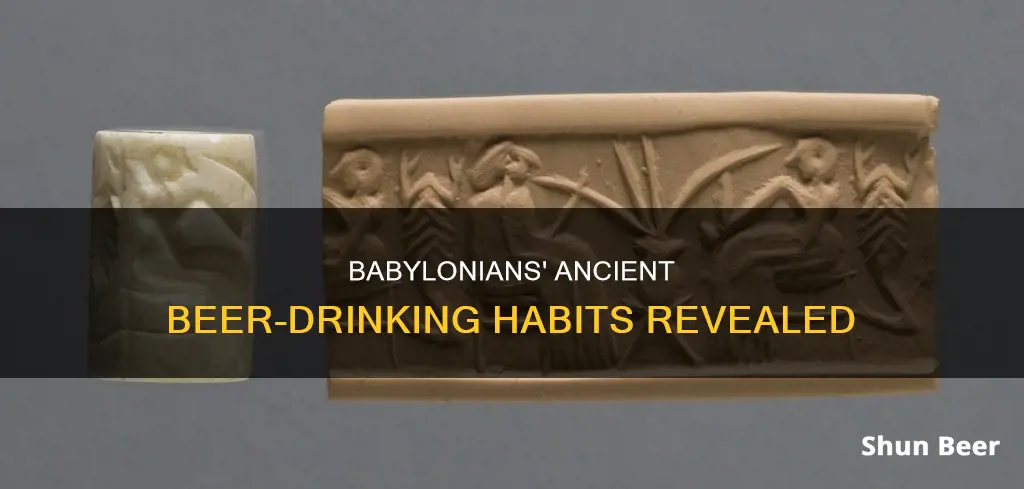
Beer was a staple in the Mesopotamian diet and was enjoyed by all social classes, from kings and queens to children. In fact, it was so popular that it was distributed according to social standing: labourers received two litres a day, while priests and administrators were given five. The Babylonians even had recipes for up to 20 different types of beer.
But how much beer did they drink in a day? Well, that's a tricky question. We know from archaeological evidence that beer was a daily staple, but we don't have specific information about how much each person drank on average. However, we can assume that the amount consumed varied depending on factors such as social standing and individual preference.
| Characteristics | Values |
|---|---|
| Who drank beer? | Everybody: rich and poor, male and female, young and old, kings, queens, soldiers, farmers, messengers, carpenters, priests, prostitutes, musicians, children |
| Where did they drink it? | At home, on the job, at feasts and festivals, in the temple, at the neighborhood tavern |
| How was it drunk? | Through straws to avoid sediment |
| How much was drunk? | Laborers received two litres a day, while priests and administrators got five |
What You'll Learn

Beer was a staple in the Mesopotamian diet
The first known written record of beer is from the ancient Sumerians, in the form of a hymn to Ninkasi, the goddess of beer. The earliest archaeological evidence of beer-making, however, dates back to around 5,000 years ago at the Mijiaya site in China. In Mesopotamia, clay tablets indicate that most brewers were women, and brewing was a well-respected occupation.
Beer was often consumed through straws, which were invented to avoid the bitter solids left over from fermentation. The straws were typically made from hollow reeds, or bronze and gold for the wealthy. Beer was also distributed according to social standing: labourers received around two litres a day, while priests and administrators were given five.
The ancient Mesopotamians loved their beer, and it was considered to have healing and uplifting elements. It was also believed to be healthier than water, as boiling fresh water to make beer killed bacteria and waterborne diseases. Beer was also packed with nutrients and came in endless varieties, brewed to different strengths and flavours.
While beer was enjoyed by all, it was acknowledged to have some negative effects. In Mesopotamian literature, drinking beer was associated with confusion, loss of control, and poor judgment. It was also known to cause a hangover and sexual dysfunction. Despite these drawbacks, beer remained a central part of Mesopotamian culture and daily life.
Beer and ProctorU: What You Need to Know
You may want to see also

Beer was distributed according to social standing
Beer was a staple in the Mesopotamian diet and was enjoyed by all ranks of society. However, the amount of beer a Babylonian would drink in a day depended on their social standing. The Code of Hammurabi, an ancient Babylonian set of laws, decreed that labourers should receive two litres of beer per day, while priests and administrators were entitled to five litres.
Beer was distributed as part of daily rations to citizens, and it was also given to workers as part of their pay. It was considered to be healthier than water, which could be contaminated by animal waste, and it was also believed to have healing and uplifting properties. In the Epic of Gilgamesh, the wild man Enkidu is given beer to drink, and his "heart [grows] light" as a result.
The Babylonians had recipes for up to 20 different types of beer, and it was always unfiltered and cloudy, with bitter sediment gathering at the bottom of drinking vessels. Drinking straws were used to avoid consuming this residue. Beer was also often flavoured with spices, herbs, olive oil, cheese, carrots, and even hallucinogens like hemp and poppy.
Beer and Macros: Can You Drink and Stay on Track?
You may want to see also

Beer was drunk through straws
The Babylonians were the first people to use straws to drink beer, a practice that dates back to around 3850 BCE. The Sumerians, a Mesopotamian civilization in what is now Iraq, used straws to drink beer brewed in large vats. The straws allowed them to drink the pure liquid from the bottom, avoiding the barley, oats, and other by-products from the fermentation process that floated to the top. The vats were too big and heavy to lift and pass around, so long straws allowed people to drink comfortably.
The use of straws for drinking beer was also a communal activity. The large vats of beer were placed on the floor, and people would gather around them, drinking through their straws. This practice fostered a sense of community and allowed friends and family to relax and enjoy their beverage together.
The straws used by the Babylonians and Sumerians were made from hollow reeds, but for the wealthy, they could be adorned with metals or stones. Queen Puabi of Ur, for example, was buried with a 4.5-foot-long straw wrapped in gold foil. Archaeologists believe that straws were also used as a tool for demarcation in Mesopotamian society, with the more ornate straws signifying higher social status.
The practice of drinking beer through straws was not limited to Mesopotamia. Ancient Egyptian texts describe the use of straws for drinking beer, and archaeological evidence suggests that this practice was also common in pre-Roman Britain and ancient Armenia. Additionally, the Babylonians were not the only ancient civilization to drink beer; it was consumed by the ancient Egyptians, Greeks, Romans, and many other cultures around the world.
Cool Hand Luke: Beer or Not?
You may want to see also

Beer was used in religious ceremonies
Beer was a staple in the Mesopotamian diet and was enjoyed by men, women, and children alike. It was considered to have healing and uplifting elements, and drinking it was seen as a quality of a civilised person. Beer was also used in religious ceremonies and offered to the gods and goddesses and to the dead during drink rituals.
The Babylonians had recipes for as many as 20 different types of beer. The Code of Hammurabi, the ancient Babylonian set of laws, decreed a daily beer ration to citizens. The drink was distributed according to social standing: labourers received two litres a day, while priests and administrators were given five litres a day.
The first known written record of beer dates back to the ancient Sumerians and is in the form of a hymn to Ninkasi, the goddess of beer. This earliest beer recipe calls for soaked grains to be mixed with bread and water. The bread would have provided the source of yeast, which was the catalyst for fermentation.
In ancient Babylonia, beer was brewed by women who were also priestesses. Some types of beer were used especially in religious ceremonies.
The Babylonians' preferred alcoholic drink was a beverage fermented from the fruit of the date palm, which was closer to cider than beer. It was produced from fruit and water and fermented using natural yeast in the dates.
Post-Surgery Drinking: Non-Alcoholic Beer, Safe or Not?
You may want to see also

Beer was considered to have healing properties
The Babylonians were no strangers to beer, with evidence suggesting they had recipes for up to 20 different types. Beer was a staple in the Mesopotamian diet, enjoyed by all, including children. It was considered to be healthier than water, as the boiling of water during the brewing process killed harmful bacteria. Beer was also packed with nutrients and was believed to have healing and uplifting properties.
The Babylonians certainly held beer in high regard, with the drink featuring in various religious ceremonies and rituals. Beer was offered to the gods and goddesses, and it played a role in the famous poem, "Inanna and the God of Wisdom", where the goddess Inanna and the god of wisdom, Enki, get drunk together.
The Babylonians also associated beer with healing. Ninkasi, the goddess of beer, was believed to make fresh beer daily using the best ingredients. Her priestesses would sing a hymn in her honour while brewing, and this hymn doubled as a set of instructions for how to brew beer. The Babylonians believed that beer, like the Tigris and Euphrates rivers, brought life to those who drank it.
The ancient Babylonians also believed that drinking beer was a sign of being civilised. In the Epic of Gilgamesh, the wild man Enkidu is offered beer to drink, with the suggestion that drinking beer was a "quality" of an enlightened person.
Beer was so important to the Babylonians that it was included in the Code of Hammurabi, a set of laws governing Mesopotamian society. The Code decreed a daily beer ration to citizens, with labourers receiving two litres per day, and priests and administrators receiving five.
Drinking after one beer: What's the harm?
You may want to see also
Frequently asked questions
The Babylonians' beer consumption varied according to their social standing. Laborers received a daily ration of two litres of beer, while priests and administrators were given five litres.
The Babylonians had recipes for as many as 20 different types of beer. One ancient recipe calls for soaked grains to be mixed with bread and water. The bread would provide the source of yeast, which was the catalyst for fermentation.
No. A beverage fermented from the fruit of the date palm was also widely consumed. This drink, known as "date beer", was produced from dates, water, and a plant called kasû.







